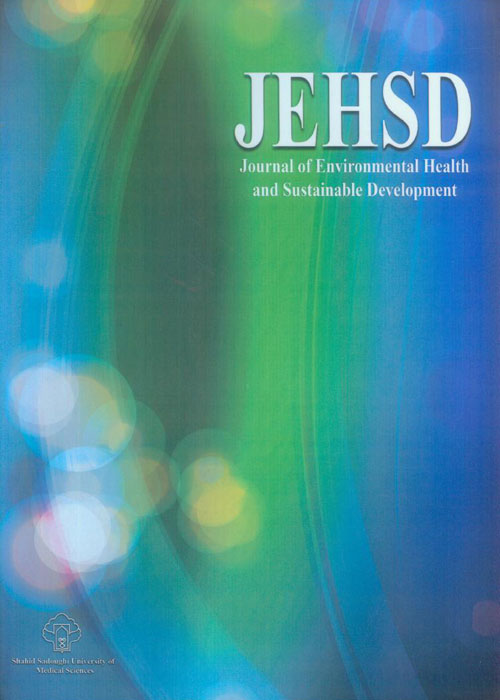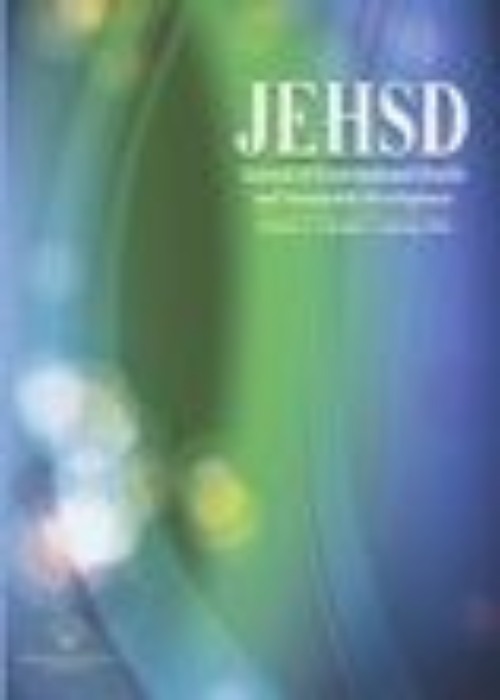فهرست مطالب

Journal of Environmental Health and Sustainable Development
Volume:1 Issue: 2, Sep 2016
- 68 صفحه،
- تاریخ انتشار: 1395/07/20
- تعداد عناوین: 8
-
Page 78IntroductionExpensive chemical tests are usuallyapplied to control the efficiency of wastewater treatment plants. However, the cost of measuring these parameters is one of the challenges of the wastewater treatment plants. Using statistical methods has been evaluated for possibility of calculating expensive parameters by measuring the inexpensive parameters in this study.MethodsInitial sample number in this study was 87cases, that were collected from SBR effluent treatment plants of Yazd as a routine sampling for two years in March 2013 to March 2015. TSS and turbidity parameters were defined as independent variables and twelve parameters including BOD5, COD, TKN, NH3, NO3, NO2, TP, TH, Ca, Mn, alkalinity, and color were the dependent variables. Spearrman test was used to investigate the significant relationship between independent and dependent variables.Linear regression analysis was used to determine the linear equation between TSS and turbidity as independent variables with BOD5, COD, TKN, NH3, NO2, TP and color as dependent variables.ResultsThe results of the regression equations in relation to turbidity and TSS with independent variables showed that the R value for color, TKN, NH3, BOD5, COD TP, and NO2 were 0.942 , 0.931 , 0.91 , 0.905 , 0.874 , 0. 872 and 0.86respectively from the highest to the lowest.ConclusionThe measured values of BOD5, COD, TKN, TP, NO2, NH3, and color in laboratory were very close to those predicted through regression equations.. Therefore, regression equations created in this study can be used to calculate expensive parameters.Keywords: Regression Equation, Advanced SBR, Effluent Wastewater, Yazd
-
Page 87IntroductionToday, have been approved scientifically relationship between presence of asbestos fibers in the human respiratory area and malignant diseases such as lung advanced fibrosis (Asbestosis), gastrointestinal, lung and Laryngeal cancers. The aim of this study was the determination of asbestos fibers concentration in Yazd citys air in the summer of 2015.MethodsThis is a descriptive cross sectional study in which 13 high-traffic points of Yazd city were selected for asbestos sampling. Sampling was conducted in the summer in two stages using SKC pump. In total was collected 26 samples from the high traffic points of Yazd city. Also for the counting of asbestos fibers was used scanning electron microscopy (SEM).ResultsIn the current research, the highest and the lowest concentration of asbestos fibers were related to Shohadayemehrab square (0.02131fiber/ml) and AzadShahr (0.00112 fiber/ml) respectively. Qualitative analysis of asbestos fibers by SEM showed that 75% of the samples were asbestos fibers and the other was non-asbestos fibers.ConclusionThe present study showed that the average of asbestos fibers concentration in total sampling stations (0.0848 fiber/ml) was higher than WHO guidelines (2.2×10-3 fiber/ml). The main reason for the presence of these fibers in the air of Yazd city can be attributed to brake pad, clutch and automobile gasket adhesive.Keywords: Asbestos Fibers, Scanning Electron Microscopy)SEM), Yazd
-
Page 94IntroductionThe development of an appropriate model for the quality control of an industrial wastewater treatment system can save the time as well as the cost. This study was performed to determine an appropriate model in order to predict the COD and TKN parameters by BOD5 and NH4 in the Meybod industrial estate waste water treatment plant (WWTP).MethodsThis descriptive analytical study was performed on 120 samples of the influent and effluent of the industrial estate wastewater treatment plant in JahanAbad, Meybod, Yazd in 2015. The studied parameters were BOD5, TKN, COD, and NH4. After measuring, they were imported to SPSS and Excel software to determine the relationship between them and then the linear regression model of the statistical method was used.ResultsThe predictive results of COD values on the basis of BOD5 in the regression model showed that the coefficient of determination was 0.88 and the correlation coefficient was 0.93 (p = 0.000) for this relationship. The prediction of TKN values on the basis of NH4 in the regression model showed that for this relationship the determination coefficient of TKN and NH4 influent parameters was 0.877 and the correlation coefficient was 0.93 (p = 0.000).ConclusionThis study represented that using the linear regression model for predicting COD and TKN values through BOD5 and NH4 was in close accordance with the laboratory data and can thus be applied when the Meybod industrial estate WWTP faces time limitations or sampling problems.Keywords: Quality control, Industrial wastewater, Linear regression model
-
Page 102IntroductionThe effects of accidents vary from minor injuries to fatalities and from insignificant damage to very severe damage to the environment and property. In order to prevent accidents in the work place, the root causes of and events should be identified using a systematic method and the results should be published. The current study aims to investigate the given causes of an accident in order to implement preventive actions in accidents and similar organizations.MethodsIn this case study, after choosing the main event; to analyze the accidents, at first a set of questions in MORT were answered. By answering the questions, the final events, and the inappropriate management risks (color-coded red) followed by the leading causes of the accident were identified.ResultsAfter analyzing the given accident, 22 inappropriate final events
(color-coded red) and 4 assumed risks were identified. Of the total 12 identified basic causes, about 75% were classified as the management policies and decision makings group, 17% as the individual factors, and 18 % as the environmental factors group.ConclusionThe analysis using MORT method helped the organization with learning lessons from the accident especially at the management level. In order to prevent the similar and dissimilar accidents, the inappropriate informational network within the organization, inappropriate operational readiness, lack of proper implementation of work permit, the inappropriate and lack of updated technical information systems regarding equipments and working process, and the inappropriate barriers should be considered in a special way.Keywords: Accident Analysis, Environmental Factors, MORT, Accident Prevention -
Page 111IntroductionOne of the methods for disposal of sludge is its usage as fertilizer on agricultural. The purpose of this study was to analyze the possibility in the application of sludge to agricultural, according to environmental standards.MethodsThis descriptive-analytic study was conducted for 12 months on dried sludge wastewater treatment plant in Yazd. Monthly sampling and tests were performed on samples in all four seasons of winter, spring, summer, and fall, thus, totally 24 samples were collected. The physical, chemical, fertilizer values, microbiological characteristics, and metal of the sludge were measured and their mean were compared with EPA standards.ResultsThe results showed that the mean of pH, TS, moisture, and organic material in the sludge were 6.58%, 58.31%, 11.37 %, 33.09 % respectively and they were in a normal range. The mean of carbon, nitrogen, phosphorus, sodium and potassium, were 61.5%, 5.47%, 4.34%, 0.43%, 0.42%, respectively which only sodium was in the range and the rest exceeded it. The mean of coliform and fecal coliform were 15062 and 2655(MPN/g), respectively and the mean of parasite eggs per 4 g/dry sludge in the four seasons was 3. The mean of metals, namely lead, iron, zinc, manganese, and copper were 19.64, 47.57, 864.23, 89.06, and 146.26 mg / kg.dry solid, respectively.ConclusionResults of the study showed that the sludge wastewater treatment in Yazd was in the range of EPA standards for Class B.Keywords: Dried sludge, Wastewater treatment plant, Yazd, Fecal coliform Heavy metals
-
Page 120IntroductionToday, the growing amount of paper consumption and consequently deforestation and environmental destruction have imposed financial burden on different countries around the world. This study aimed to determine the level of knowledge, attitude, and performance of Yazd health volunteers on cutting down the consumption of paper.MethodsThis descriptive-cross sectional study was conducted on 120
health volunteers of ShahidSadoughi university of Medical Sciences and
Health Services in 2015. A self-made questionnaire containing demographic, knowledge, attitude, and performance questions was applied as the data collection tool. The data was imported into SPSS software V.18 and analyzed with t-test and ANOVA statistical tests.ResultsThe participant's knowledge about importance of paper consumption was 80.03%. The mean and standard deviation scores of knowledge, attitude, and performance of health volunteers were 11.09 ±2.90, 59.82±2.23, and 41.11 ±9.50 respectively. The results suggested that the average scores of knowledge and attitude among those with academic degrees were higher than that of other participants and this relation was statistically significant(p≤0.001). The attitude of married subjects compared to single volunteer's was more positive and there was a significant difference between their attitude and income levels. According to the results, there was a positive and significant correlation between knowledge and attitude as well as attitude and performance (PConclusionThe findings showed that the level of knowledge, attitude, and performance of health volunteers in Yazd regarding cutting down paper consumption is at a satisfactory level. This suggests that trainings provided for them at different time intervals have been well enough.Keywords: Knowledge, Attitude, Health volunteers, Paper consumption, Yazd -
Page 128Introductionsequential batch reactor (SBR) is one of the modified biological treatment systems which is able to remove BOD5, Nitrogen, and phosphorus from wastewater. The object of this study is to determine the removal efficiency of nitrogen, phosphorus, and heavy metals from municipal wastewater by the advanced SBR system.MethodsThis descriptive-analytical and cross-sectional study was conducted on advanced SBR in Yazd city wastewater treatment plant during a one-year period (from September, 2014 until August, 2015). The samples were collected from the influent and effluent of the advanced SBR as a composite in order to measure BOD5, TKN, NH4, TP parameters, and heavy metals monthly. Also, statistical t-test was used to compare heavy metals quantities with standard ones.ResultsThe results showed that the mean of removal efficiency of BOD5, TKN, NH4, and TP were 92.24, 80.36, 90.41, and 66.41 percent, respectively. Also, the removal efficiency of Iron (Fe), Plumbum (Pb), Nickel (Ni), Zink (Zn), Chromium (Cr), and Cadmium (Cd) were 47.77%, 40.71%, 24.79%, 12.29%, 5.70%, and 5.65%, respectively.ConclusionThe high removal efficiency of BOD5, TKN, and NH4 showed that this advanced SBR system had an appropriate efficiency for nitrification. Phosphorus removal (TP) had a lower efficiency than those of NH4 and TKN, but it was within the environmental standard limits. On the other hand, in the advanced SBR the removal efficiency of heavy metals for Cd was not within the standard limits.Keywords: Advanced SBR, Wastewater treatment, Nitrogen, Phosphorus, Heavy metal, Yazd


